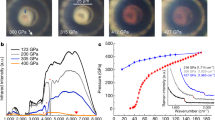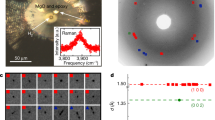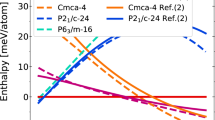Abstract
Hydrogen is the most abundant element in the Universe. However, understanding the properties of dense hydrogen is still an open challenge because—under megabar pressures—the quantum nature of both electrons and protons emerges, producing deviations from the common behaviour of condensed-matter systems. Experiments are challenging and can access only limited observables, and the interplay between electron correlation and nuclear quantum motion makes standard simulations unreliable. Here we present the computed phase diagram of hydrogen and deuterium at low temperatures and high pressures using state-of-the-art methods to describe both many-body electronic correlation and quantum anharmonic motion of protons. Our results show that the long-sought atomic metallic hydrogen phase—predicted to host room-temperature superconductivity—forms at 577(4) GPa. The anharmonic vibrations of nuclei pushes the stability of this phase towards pressures much larger than previous estimates or attained experimental values. Before atomization, molecular hydrogen transforms from a metallic phase (phase III) to another metallic structure that is still molecular (phase VI) at 410(20) GPa. Isotope effects increase the pressures of both transitions by 63 and 32 GPa, respectively. We predict signatures in optical spectroscopy and d.c. conductivity that can be experimentally used to distinguish between the two structural transitions.
This is a preview of subscription content, access via your institution
Access options
Access Nature and 54 other Nature Portfolio journals
Get Nature+, our best-value online-access subscription
$29.99 / 30 days
cancel any time
Subscribe to this journal
Receive 12 print issues and online access
$209.00 per year
only $17.42 per issue
Buy this article
- Purchase on Springer Link
- Instant access to full article PDF
Prices may be subject to local taxes which are calculated during checkout




Similar content being viewed by others
Data availability
The structures employed in the calculation, including the new P62/c-24 crystalline symmetry obtained after structural relaxation with quantum anharmonicity, are freely available via Materials Cloud43. All other data are available from the corresponding authors upon reasonable request from L.M. and M.C.
Code availability
The SSCHA and QUANTUM ESPRESSO codes used in this research are open source: the SSCHA suite can be downloaded from www.sscha.eu and the QMC TurboRVB package is available upon request from M.C. (michele.casula@upmc.fr) or K.N. (kousuke_1123@icloud.com).
References
Ashcroft, N. W. Metallic hydrogen: a high-temperature superconductor? Phys. Rev. Lett. 21, 1748–1749 (1968).
Mao, H.-k & Hemley, R. J. Ultrahigh-pressure transitions in solid hydrogen. Rev. Mod. Phys. 66, 671 (1994).
Howie, R. T., Guillaume, C. L., Scheler, T., Goncharov, A. F. & Gregoryanz, E. Mixed molecular and atomic phase of dense hydrogen. Phys. Rev. Lett. 108, 125501 (2012).
Dalladay-Simpson, P., Howie, R. T. & Gregoryanz, E. Evidence for a new phase of dense hydrogen above 325 gigapascals. Nature 529, 63–67 (2016).
Loubeyre, P., Occelli, F. & Dumas, P. Synchrotron infrared spectroscopic evidence of the probable transition to metal hydrogen. Nature 577, 631–635 (2020).
Eremets, M. I., Drozdov, A. P., Kong, P. P. & Wang, H. Semimetallic molecular hydrogen at pressure above 350 GPa. Nat. Phys. 15, 1246–1249 (2019).
Dias, R. P. & Silvera, I. F. Observation of the Wigner-Huntington transition to metallic hydrogen. Science 355, 715–718 (2017).
Borinaga, M., Ibañez-Azpiroz, J., Bergara, A. & Errea, I. Strong electron-phonon and band structure effects in the optical properties of high pressure metallic hydrogen. Phys. Rev. Lett. 120, 057402 (2018).
Goncharov, A. F. & Struzhkin, V. V. Comment on ‘observation of the Wigner-Huntington transition to metallic hydrogen’. Science 357, eaam9736 (2017).
Silvera, I. F. & Dias, R. Response to comment on ‘observation of the Wigner-Huntington transition to metallic hydrogen’. Science 357, eaan2671 (2017).
Loubeyre, P., Occelli, F. & Dumas, P. Comment on: observation of the Wigner-Huntington transition to metallic hydrogen. Preprint at https://arxiv.org/abs/1702.07192 (2017).
Ji, C. et al. Ultrahigh-pressure isostructural electronic transitions in hydrogen. Nature 573, 558–562 (2019).
Straus, D. M. & Ashcroft, N. W. Self-consistent structure of metallic hydrogen. Phys. Rev. Lett. 38, 415–418 (1977).
Errea, I. et al. High-pressure hydrogen sulfide from first principles: a strongly anharmonic phonon-mediated superconductor. Phys. Rev. Lett. 114, 157004 (2015).
Errea, I. et al. Quantum crystal structure in the 250-kelvin superconducting lanthanum hydride. Nature 578, 66–69 (2020).
Drummond, N. D. et al. Quantum Monte Carlo study of the phase diagram of solid molecular hydrogen at extreme pressures. Nat. Commun. 6, 7794 (2015).
Foulkes, W. M. C., Mitas, L., Needs, R. J. & Rajagopal, G. Quantum Monte Carlo simulations of solids. Rev. Mod. Phys. 73, 33–83 (2001).
Errea, I., Calandra, M. & Mauri, F. Anharmonic free energies and phonon dispersions from the stochastic self-consistent harmonic approximation: application to platinum and palladium hydrides. Phys. Rev. B 89, 064302 (2014).
Bianco, R., Errea, I., Paulatto, L., Calandra, M. & Mauri, F. Second-order structural phase transitions, free energy curvature, and temperature-dependent anharmonic phonons in the self-consistent harmonic approximation: theory and stochastic implementation. Phys. Rev. B 96, 014111 (2017).
Monacelli, L., Errea, I., Calandra, M. & Mauri, F. Pressure and stress tensor of complex anharmonic crystals within the stochastic self-consistent harmonic approximation. Phys. Rev. B 98, 024106 (2018).
Monacelli, L. et al. The stochastic self-consistent harmonic approximation: calculating vibrational properties of materials with full quantum and anharmonic effects. J. Phys.: Condens. Matter 33, 363001 (2021).
McMinis, J., Clay, R. C., Lee, D. & Morales, M. A. Molecular to atomic phase transition in hydrogen under high pressure. Phys. Rev. Lett. 114, 105305 (2015).
Azadi, S., Drummond, N. D. & Foulkes, W. M. C. Nature of the metallization transition in solid hydrogen. Phys. Rev. B 95, 035142 (2017).
Monserrat, B. et al. Structure and metallicity of phase V of hydrogen. Phys. Rev. Lett. 120, 255701 (2018).
Azadi, S., Monserrat, B., Foulkes, W. M. C. & Needs, R. J. Dissociation of high-pressure solid molecular hydrogen: a quantum Monte Carlo and anharmonic vibrational study. Phys. Rev. Lett. 112, 165501 (2014).
Miehlich, B., Savin, A., Stoll, H. & Preuss, H. Results obtained with the correlation energy density functionals of Becke and Lee, Yang and Parr. Chem. Phys. Lett. 157, 200–206 (1989).
Kohanoff, J., Scandolo, S., de Gironcoli, S. & Tosatti, E. Dipole-quadrupole interactions and the nature of phase III of compressed hydrogen. Phys. Rev. Lett. 83, 4097–4100 (1999).
Pickard, C. J. & Needs, R. J. Structure of phase III of solid hydrogen. Nat. Phys. 3, 473–476 (2007).
Azadi, S. & Kühne, T. D. Unconventional phase III of high-pressure solid hydrogen. Phys. Rev. B 100, 155103 (2019).
Monacelli, L., Errea, I., Calandra, M. & Mauri, F. Black metal hydrogen above 360 GPa driven by proton quantum fluctuations. Nat. Phys. 17, 63–67 (2020).
Borinaga, M., Errea, I., Calandra, M., Mauri, F. & Bergara, A. Anharmonic effects in atomic hydrogen: superconductivity and lattice dynamical stability. Phys. Rev. B 93, 174308 (2016).
Liu, H., Wang, H. & Ma, Y. Quasi-molecular and atomic phases of dense solid hydrogen. J. Phys. Chem. C 116, 9221–9226 (2012).
Morresi, T., Paulatto, L., Vuilleumier, R. & Casula, M. Probing anharmonic phonons by quantum correlators: a path integral approach. J. Chem. Phys. 154, 224108 (2021).
Tran, F. & Blaha, P. Accurate band gaps of semiconductors and insulators with a semilocal exchange-correlation potential. Phys. Rev. Lett. 102, 226401 (2009).
Gorelov, V., Holzmann, M., Ceperley, D. M. & Pierleoni, C. Energy gap closure of crystalline molecular hydrogen with pressure. Phys. Rev. Lett. 124, 116401 (2020).
Nimier-David, M., Vicini, D., Zeltner, T. & Jakob, W. Mitsuba 2: a retargetable forward and inverse renderer. ACM Trans. Graph. 38, 203 (2019).
Zhang, C. et al. Finite-temperature infrared and Raman spectra of high-pressure hydrogen from first-principles molecular dynamics. Phys. Rev. B 98, 144301 (2018).
Prandini, G., Rignanese, G.-M. & Marzari, N. Photorealistic modelling of metals from first principles. Mater. 5, 129 (2019).
Clay, R. C. et al. Benchmarking exchange-correlation functionals for hydrogen at high pressures using quantum Monte Carlo. Phys. Rev. B 89, 184106 (2014).
Giannozzi, P. et al. QUANTUM ESPRESSO: a modular and open-source software project for quantum simulations of materials. J. Phys.: Condens. Matter 21, 395502 (2009).
Giannozzi, P. et al. Advanced capabilities for materials modelling with quantum ESPRESSO. J. Phys.: Condens. Matter 29, 465901 (2017).
Nakano, K. et al. TurboRVB: a many-body toolkit for ab initio electronic simulations by quantum Monte Carlo. J. Chem. Phys. 152, 204121 (2020).
Monacelli, L., Casula, M., Nakano, K., Sorella, S. & Mauri, F. Quantum phase diagram of high-pressure hydrogen. Materials Cloud https://doi.org/10.24435/MATERIALSCLOUD:R1-WK (2022).
Acknowledgements
L.M. acknowledges CINECA under the ISCRA initiative for providing high-performance computational (HPC) resources employed in this work, and PRACE for providing computational resources under project no. ra0020 on Joliot-Curie Rome at TGCC, France. M.C. thanks GENCI for providing computational resources under grant no. 0906493, the Grands Challenge DARI for allowing calculations on the Joliot-Curie Rome HPC cluster under project no. gch0420. M.C., K.N. and S.S. thank RIKEN for providing computational resources of the supercomputer Fugaku through the HPCI System Research Projects (project IDs, hp210038 and hp220060). K.N. acknowledges support from the JSPS Overseas Research Fellowships, Grant-in-Aid for Early Career Scientists (grant no. JP21K17752) and Grant-in-Aid for Scientific Research (grant no. JP21K03400). S.S. acknowledges support from MIUR, PRIN-2017BZPKSZ. This work was supported by the European Centre of Excellence in Exascale Computing TREX: Targeting Real Chemical Accuracy at the Exascale. This project has received funding from the European Union’s Horizon 2020 research and innovation programme under grant agreement no. 952165.
Author information
Authors and Affiliations
Contributions
L.M., M.C. and F.M. conceived the work, and L.M. conducted all the DFT and SSCHA simulations, including those for the optical properties. M.C. and S.S. performed the QMC calculations, and M.C. and L.M. collaborated on analysing the results to derive the final phase diagram for hydrogen. Additionally, K.N. and S.S. contributed to develop the QMC TurboRVB software that enabled the large-scale calculations performed in this work. All the authors participated in writing the paper.
Corresponding authors
Ethics declarations
Competing interests
The authors declare no competing interests.
Peer review
Peer review information
Nature Physics thanks Xin-Zheng Li and the other, anonymous, reviewer(s) for their contribution to the peer review of this work.
Additional information
Publisher’s note Springer Nature remains neutral with regard to jurisdictional claims in published maps and institutional affiliations.
Extended data
Extended Data Fig. 1 DFT-BLYP phase diagram of high-pressure hydrogen.
The static lattice enthalpies are in panel (a). We report the quasi-harmonic phase-diagram of hydrogen (panel b) and deuterium (panel c). The main structures (Cmca-12, C2/c-24 and Cs-IV) are reported in all panels. In panel d, we show the anharmonic (SSCHA) entalpies of hydrogen. Shaded area represent the bootstrap procedure: raw data from simulations are randomized with a normal distribution to represent the stochastic error of the SSCHA free energy and pressure. Each randomized data is displayed as a shaded line. Errors on the transition pressures are the standard deviation over the randomized data. Panel e reports the anharmonic enthalpy of deuterium.
Extended Data Fig. 2 DMC phase diagram of high-pressure hydrogen.
This is an extended version of Fig. 2, where we report the enthalpies also for the static and harmonic phase-diagrams. The static lattice enthalpy is in panel a. Quasi-harmonic phase-diagram of hydrogen is reported in panel b (in panel c for deuterium). The main structures (Cmca-12, C2/c-24 and Cs-IV) are shown in all panels. In panel c, we report the quasi-harmonic phase diagram of deuterium. In panel d, we show the anharmonic (SSCHA) entalpies of hydrogen. This is the same as Fig. 2a. Anharmonic entalpies of deuterium are plotted in panel e, the same as Fig. 2b.
Extended Data Fig. 3 Reflectivity (upper row) and DOS (lower row) of phase III (C2/c-24) and phase VI (Cmca-12) at different pressures.
The pressures reported correspond to volumes of 1.62 Å3,1.42 Å3 and 1.25 Å3 per H atom, and they are averaged over the two phases (the actual pressures differ at most by 5 GPa from the average).
Extended Data Fig. 4 Real (upper panels) and imaginary (lower panels) part of the conductivity of Cmca-12 and Cs-IV phases.
The simulations are performed at constant volumes of 1.25 Å3, 1.12 Å3, 1.06 Å3 per H atom, as those in Fig. 3, and the corresponding pressure reported refers to the value for the most stable structure at that volume.
Extended Data Fig. 5 Comparison of zero-point energy with different DFT functionals.
Phonon DOS of C2/c-24 and Cmca-12 crystalline symmetries, and zero-point energy (ZPE) difference between the two, computed with PBE, BLYP and VDW-DF functionals. Both DOS and ZPE are evaluated only at Γ. While PBE strongly underestimates the vibron frequencies and the absolute value of the ZPE difference, BLYP and VDW-DF yield almost identical results.
Extended Data Fig. 6 Rotational degrees of freedom in Cmca-12.
In panel a, we report the fit of the DFT-BLYP energy landscape for the rotation of one H2 molecule inside the Cmca-12 structure at 350 GPa. The intramolecular H2 potential is fitted with a Morse function in panel b. In panel c, we report the probability distribution of the reduced coordinate in the center-of-mass frame solved with the implicitly-restarted Lanczos algorithm (ground state and first excited states). Axes are in Bohr. The difference between the SSCHA ZPE and the exact ground-state as a function of the amplitude of the angular potential modulation is reported in panel d. The dashed line represent the value of the fit in panel a.
Extended Data Fig. 7 QMC finite-size scaling and extrapolation to the thermodynamic limit.
KZK-corrected lattice-regularized DMC energies for 4 crystalline symmetries (C2/c-24, Cmca-12, Cmca-4, and Cs-IV) plotted as a function of 1/N, where N is the number of atoms in the supercell, with respect to their value at N = 96, taken as reference. The energies are twisted-averaged in the canonical ensemble over a k-grid that has been rescaled according to the size of the supercell, as explained in SI. Note that despite the KZK correction and the canonical k-average, there is a residual size dependence beyond N = 96, larger than the target accuracy of ± 1 meV per atom, that needs to be extrapolated. As expected, this residual dependence is stronger in the atomic metallic phase and in the molecular phases under higher pressure, where the metallic character is enhanced.
Extended Data Fig. 8 QMC corrections of DFT-BLYP energies.
We plot the electronic energy differences between DFT-BLYP and DMC calculations at hydrogen centroid positions obtained from SSCHA nuclear quantum fluctuations evaluated at the DFT-BLYP level. The DMC energies are computed within the fixed-node approximation with DFT-LDA nodes (see SI for more details). The fit is a straight line for all phases. The absolute value of the shift includes the effect of the pseudopotential.
Supplementary information
Supplementary Information
Supplementary Figs. 1–17, Tables 1–5 and Discussion.
Rights and permissions
Springer Nature or its licensor (e.g. a society or other partner) holds exclusive rights to this article under a publishing agreement with the author(s) or other rightsholder(s); author self-archiving of the accepted manuscript version of this article is solely governed by the terms of such publishing agreement and applicable law.
About this article
Cite this article
Monacelli, L., Casula, M., Nakano, K. et al. Quantum phase diagram of high-pressure hydrogen. Nat. Phys. 19, 845–850 (2023). https://doi.org/10.1038/s41567-023-01960-5
Received:
Accepted:
Published:
Issue Date:
DOI: https://doi.org/10.1038/s41567-023-01960-5
This article is cited by
-
Prediction of ambient pressure conventional superconductivity above 80 K in hydride compounds
npj Computational Materials (2024)



